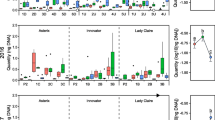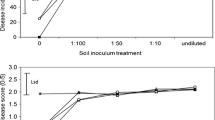Abstract
Potato seed certification is a disease management tool that minimises the risk of spreading seed tuber-borne inoculum of infectious diseases. Traditionally, certification sampling strategies have relied upon visual assessment of a seedlot from samples taken at one or two points within the load of seed tubers. However methodologies in selection of tuber samples have not been critically assessed for their precision in estimating disease load. This study presents an analysis of 37 potato seedlots over a 3 year period. Analysis of sample data using receiver operating curves (ROCs) indicates that point sampling taking two samples of 100 tubers at the beginning and end of a seedlot gives equivalent disease estimation as a continuous sampling strategy taking ten samples of 20 tubers randomly throughout the seedlot, although at lower statistical precision. This was confirmed both by visual assessment of tuber-borne disease and by analysis of pathogen DNA content from tuber peel. Across the 3 years of study, powdery scab and black scurf were the major seed tuber-borne diseases recognised and this corresponded with high levels of pathogen DNA from peel analysis for both Spongospora subterranea and Rhizoctonia solani AG3 respectively.

Similar content being viewed by others
References
Adams, M. J., & Hide, G. A. (1981). Effects of common scab (Streptomyces scabies) on potatoes. Annals of Applied Biology, 98, 211–216.
Andrade, S. N., Contreras, M. A., & Castro, U. I. (2008). Effect of using certified and uncertified potato seeds on the yield and sanitary conditions of a potato crop. Agro Sur, 36, 63–66.
Bouchek-Mechiche, K., Montfort, F., & Merz, U. (2011). Evaluation of the Sss AgriStrip rapid diagnostic test for the detection of Spongospora subterranea on potato tubers. European Journal of Plant Pathology, 131, 277–287.
Bulman, S., & Marshall, J. (1998). Detection of Spongospora subterranea in potato tuber lesions using the polymerase chain reaction (PCR). Plant Pathology, 47, 759–766.
Campion, C., Chatot, C., Perraton, B., & Andrivon, D. (2003). Anastomosis groups, pathogenicity and sensitivity to fungicides of Rhizoctonia solani isolates collected on potato crops in France. European Journal of Plant Pathology, 109, 983–992.
Crump, N. (2005). Prediction and molecular detection of soilborne pathogens of potato. Sydney: Horticulture Australia.
Falloon, R. E., Wallace, A. R., Braithwaite, M., Genet, R. A., Nott, H. M., Fletcher, J. D., & Braam, W. F. (1996). Assessment of seed tuber, in-furrow, and foliar chemical treatments for control of powdery scab (Spongospora subterranea f sp subterranea) of potato. New Zealand Journal of Crop and Horticultural Science, 24, 341–353.
Fiers, M., Edel-Hermann, V., Chatot, C., Le Hingrat, Y., Alabouvette, C., & Steinberg, C. (2012). Potato soil-borne diseases. A review. Agronomy for Sustainable Development, 32, 93–132.
Hooker, W. J. (1981). Compendium of potato diseases. St Paul MN: APS Press.
Kirkwood, I. (2010). Australian potato research program: program overview. In I. Kirkwood (Ed.), Australian potato research program final report to Horticulture Australia for project PT04016. Sydney: Horticulture Australia.
Krzanowski, W. J., & Hand, D. J. (2009). ROC curves for continuous data. Boca Raton: CRC Press, Chapman and Hall.
Lapwood, D. H. (1972). The relative importance of weather, soil- and seed-borne inoculum in determining the incidence of common scab (Streptomyces scabies) in potato crops. Plant Pathology, 21, 105–108.
Merz, U., & Falloon, R. E. (2009). Review: Powdery scab of potato- Increased knowledge of pathogen biology and disease epidemiology for effective disease management. Potato Research, 52, 17–37.
Ophel-Keller, K., McKay, A., Harding, R., Hall, B., Wicks, T., Wiechel, T., Crump, N., Shah, F., Marshall, J., & Falloon, R. (2009). DNA monitoring tools for soil-borne pathogens of potato. In I. Kirkwood (Ed.), Australian potato research program final report to Horticulture Australia for project PT04016. Sydney: Horticulture Australia.
Ophel-Keller, K., McKay, A., Hartley, D., Herdina, & Curran, J. (2008). Development of a routine DNA-based testing service for soilborne diseases in Australia. Australasian Plant Pathology, 37, 243–253.
R Development Core Team. (2012). R: A language and environment for statistical computing. Vienna: R Foundation for Statistical Computing.
SASA (2010). Scottish Seed Potatoes. Retrieved May 2, 2013, from http://www.sasa.gov.uk/sites/default/files/SPCS%20Leaflet.pdf.
Shah, F. A., Falloon, R. E., Butler, R. C., & Lister, R. A. (2012). Low amounts of Spongospora subterranea sporosorus inoculum cause severe powdery scab, root galling and reduced water use in potato (Solanum tuberosum). Australasian Plant Pathology, 41, 219–228.
Sing, T., Sander, O., Beerenwinkel, N., & Lengauer, T. (2005). ROCR: visualizing classifier performance in R. Bioinformatics, 21, 3940–3941.
Sparrow, L., & Wilson, C. (2012). Managing and monitoring viral and soil-borne pathogens in Tasmanian potato crops. In Z. He, R. Larkin, & W. Honeycutt (Eds.), Sustainable potato production: Global case studies (pp. 309–325). Netherlands: Springer.
Tegg, R. S., Gill, W. M., Thompson, H. K., Davies, N. W., Ross, J. J., & Wilson, C. R. (2008). Auxin-induced resistance to common scab disease of potato linked to inhibition of thaxtomin A toxicity. Plant Disease, 92, 1321–1328.
Tegg, R. S., Thangavel, T., Aminian, H., & Wilson, C. R. (2013). Somaclonal selection in potato for resistance to common scab provides concurrent resistance to powdery scab. Plant Pathology, 62, 922–931.
Truter, M., & Wehner, F. C. (2004). Anastomosis grouping of Rhizoctonia solani associated with black scurf and stem canker of potato in South Africa. Plant Disease, 88, 83.
Tsror, L. (2010). Biology, epidemiology and management of Rhizoctonia solani on potato. Journal of Phytopathology, 158, 649–658.
Tsror, L., & Peretz-Alon, I. (2005). The influence of the inoculum source of Rhizoctonia solani on development of black scurf on potato. Journal of Phytopathology, 153, 240–244.
UNECE (2011). UNECE Standard S-1 concerning the marketing and commercial quality control of seed potatoes. Retrieved November 10, 2012, from http://www.unece.org/fileadmin/DAM/trade/agr/standard/potatoes/S-1_2011_E.pdf.
van de Graaf, P., Lees, A. K., Wale, S. J., & Duncan, J. M. (2005). Effect of soil inoculum level and environmental factors on potato powdery scab caused by Spongospora subterranea. Plant Pathology, 54, 22–28.
VICSPA (2007). Australian National Standard Certification of Seed Potatoes. Retrieved May 2, 2013, from http://www.vicspa.org.au/pdfs/NatStand04.pdf.
Wang, A., & Lazarovits, G. (2005). Role of seed tubers in the spread of plant pathogenic Streptomyces and initiating potato common scab disease. American Journal of Potato Research, 82, 221–230.
Wilson, C. R., Ransom, L. M., & Pemberton, B. M. (1999). The relative importance of seed-borne inoculum to common scab disease of potato and the efficacy of seed tuber and soil treatments for disease control. Journal of Phytopathology, 147, 13–18.
Wilson, C. R., Tegg, R. S., Wilson, A. J., Luckman, G. A., Eyles, A., Yuan, Z. Q., Hingston, L. H., & Conner, A. J. (2010). Stable and extreme resistance to common scab of potato obtained through somatic cell selection. Phytopathology, 100, 460–467.
Acknowledgements
We thank Iain Kirkwood for initial project conception and development. We also thank Philip Beveridge, Ann-Maree Donoghue and Leonie White for the collection of seedlot samples and assistance with the visual inspections. The research presented is part of a multi-pronged research drive through the Australian Potato Research Program (Phase 2), funded by Horticulture Australia Limited using the processing potato industry levy and matched funds from the Federal Government. The University of Tasmania/Tasmania Institute of Agriculture has provided in-kind support.
Author information
Authors and Affiliations
Corresponding author
Rights and permissions
About this article
Cite this article
Tegg, R.S., Corkrey, R. & Wilson, C.R. A comparison of potato seed-tuber sampling strategies using visual and DNA analyses to estimate incidence of major seed tuber-borne pathogens. Eur J Plant Pathol 139, 359–367 (2014). https://doi.org/10.1007/s10658-014-0392-y
Accepted:
Published:
Issue Date:
DOI: https://doi.org/10.1007/s10658-014-0392-y




